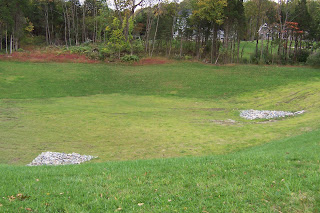Unify Your Garden Design With Similar Materials
(PHOTO: Red Butte Garden, Utah uses red flagstones for paths and paved terraces throughout the garden.)
With such an interesting variety of hardscape materials and plants available to work with in the garden today, homeowners may be tempted to use several of them, rather than engage with the effort of choosing among them. Coupled with the popularity of creating multiple garden rooms with differing themes, the garden space that was meant to be soothing, harmonious, and calming can quickly become a visual cacophony that leaves us jittery and unsettled instead.
Professional landscape designers and architects should be able to handle these challenges, but what if you're designing the garden yourself? The garden's native setting holds all of the clues to tying it to the larger landscape. Start with what's beneath your feet. What type of rock are you standing on? In our small town, there are three distinct geologic formations that dominate: Granite, several varieties of limestone, and slate and shale. Whether you're using natural stone or manufactured pavers, choose materials for walls and walks that are similar to the native stone in order to unify the space: Bluestone flags with slate and shale; Belgian blocks with granite, etc.
Next, take a look at the trees. Are they primarily hardwoods (deciduous), such as oak, hickory, or maple, or softwoods such as cedars, spruces, or pines? How much natural forest do you have? Will the red foliage of a copper beech or Japanese maple look jarring amongst the rest of the trees, or do you have sufficient lawn space for it to stand on its own as a specimen? Except where large-scale clearing (as for agricultural fields, mining, etc.) or reforestation has taken place, forests in their natural state support a wide variety of tree sizes, from saplings to mature giants. Unless you're constructing a formal allée of trees, plant a variety of different sizes.
Constructing a series of garden rooms with differing themes is a complex undertaking that requires that they be screened from one another, yet still provide a sense of flow. Unless you're up for lots of mistakes and do-overs, leave this to the professionals. More in line with the ability of do-it-yourselfers are garden rooms based on function – such as a dining area, a spa or hot tub area, meditation or yoga area, and, of course a garden reading/dreaming/planning room. These types of spaces can be unified by using the same material throughout for paths or fencing; by repeating plants or decorative motifs (such as Arts and Crafts tiles, Japanese lanterns, paint colors); or by introducing common elements, such as a serpentine fieldstone wall, or the benches Monét positioned throughout his garden.
What simple element could you add to your garden to draw its disparate components together?


